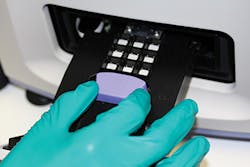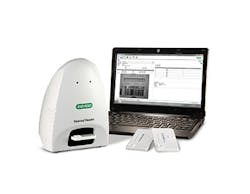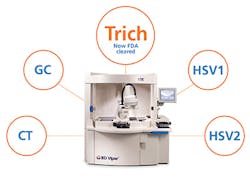April 2015 Product Focus – Deploying diagnostics in the fight against STIs
Deploying diagnostics in the fight against sexually transmitted infections
Infectious diseases by nature are complex and are often multifaceted, and this is particularly seen within sexually transmitted infections (STIs). Historically regarded as “curable,” bacterial sexually transmitted infections such as chlamydia and gonorrhea were effectively treated with antibiotics; however, over the years STIs have evolved and acquired resistance to many antibiotic treatments, resulting in a depleted pool of therapeutic options available to treat these increasingly common infections.1,2
Firing blanks: the end of the magic bullet
Until recently, antibiotics were hailed as the panacea to curing many bacterial infectious diseases, yet today we are faced with a situation where our overuse and misuse of these, “magic bullets” has resulted in us firing blanks against infection. Indeed, the U.S. Centers for Disease Control and Prevention (CDC) has classified drug-resistant Neisseria gonorrhoea an urgent threat level, defined as an immediate public health threat which requires urgent and aggressive action.2
In 2011, more than 320,000 cases of Neisseria gonorrhoea were reported to the CDC, but estimates show that more than 800,000 cases occur annually in the United States. The Gonococcal Isolate Surveillance Project (GISP) found that 30 percent of gonorrhea infections were resistant to any antibiotic, with almost a quarter of a million cases reported.2
The efficacy of fluoroquinolones in the treatment of Neisseria gonorrhoea waned more than a decade ago. Indeed, it has been reported by 36 countries that cefixime is the last line of treatment against Neisseria gonorrhoea, yet treatment failures with this drug have been recorded since 2007 in Japan, Australia, Canada, France, Norway, South Africa, and the UK. Similarly, reports of treatment failure of pharyngeal gonorrhea with ceftriaxone have been documented in Australia, Japan, Slovenia, and Sweden.3
The geographical spread of STI-associated antibiotic resistance is clearly not isolated to one country or region, highlighting the routine overuse of antibiotics by public health systems worldwide. The unchecked habit in the developed world of over-prescribing antibiotics, juxtaposed with the limited antibiotic options in developing countries, has resulted in a unique situation where the global population stands united in its vulnerability to infection.
The failure of public health messages in preventing STI spread and our reliance on a diminishing portfolio of effective antibiotics to treat sexually transmitted infections has resulted in an increasing threat from such infections. In addition, pharmaceutical companies, getting little encouragement to develop alternative therapeutic options, have very few, if any, new and effective antibiotics in the pipeline. The most effective approach that remains to limit the spread of STIs is, therefore, early and accurate detection of infection through pioneering new molecular-based diagnostic technologies.3
What lies beneath: unmasking co-infections
The majority of STIs are present without symptoms; therefore, diagnosis of infections can only be definitively made through comprehensive screening for a wide panel of pathogens.4 This is particularly important for detection of co-infections, which can remain undetected as they are masked behind symptoms of the dominant, or diagnosed, primary infection. These “silent” infections may prolong patients’ exposure to pathogens and impede the efficacy of the treatment regime, affecting their recovery; therefore, diagnosis of all pathogens present is paramount for prescribing of optimal treatments, based on specific infection and reported resistance indications.
More than 30 bacterial, viral, and parasitic pathogens have been identified to date that can be transmitted sexually,4 yet most laboratories screen only for the two most common bacteria, Chlamydia trachomatis and Neisseria gonorrhoea, without further investigating other potential infective bacteria, viruses, or protozoa.
Molecular laboratory testing is the key to identifying both causal infection and co-infections. Highly sensitive and specific molecular assays which permit multiplex screening of a wide range of pathogens enable more efficient, targeted screening. These assays have the power to uncover primary and secondary bacterial, viral, and protozoan infections in one rapid screen, providing substantial benefits not only to the molecular laboratory performing the test, but also to health authorities conducting surveillance, and of course to the patient and wider public.
Utilizing multiplex molecular assays to detect a wider range of STIs will not only provide substantial time and cost savings to the laboratories and ease the burden on the payer, but in a surveillance setting will further understanding of how pathogens are adapting, spreading, and reacting to current treatment. In turn, this will enable public health authorities to accurately monitor which STIs are circulating in the community and adjust public health policy accordingly. Improved tracking of resistance to antibiotics will more accurately inform treatment options and contribute much-needed surveillance statistics to the global data bank for a clearer understanding of the scale of the problem worldwide.
From the patient’s perspective, accurate and rapid diagnosis at first presentation reduces the length of exposure to infectious diseases for improved long-term reproductive health. The necessity for repeat visits to the clinician is also reduced, and appropriate therapeutics can be administered in a timely manner, for optimal treatment of infection.
Rebuilding our defenses
Adopting routine use of molecular assays to test for infectious pathogens at first presentation is a protective strategy to ensure appropriate treatment and control of infection in the community. In particular, multiplex diagnostic assays that simultaneously test for a wide range of infections are widely being considered the optimal method for diagnosis and management of disease. Not only will test results improve patient outcomes, but they will contribute to our understanding of the epidemiology of infection. This will empower us with a wealth of new information on resistance, geographical distribution, and risk groups to help rebuild our defenses against the threat of sexually transmitted infections.
References
- World Health Organization. Global incidence and prevalence of selected curable sexually transmitted infections 2008. Available online: http://www.who.int/reproductivehealth/publications/rtis/stisestimates/en/. Accessed February 13, 2015.
- U.S. Department of Health and Human Services Centers for Disease Control and Prevention. Antibiotic Resistance Threats in the United States 2013. http://www.cdc.gov/drugresistance/pdf/ar-threats-2013-508.pdf. Accessed February 13, 2015.
- World Health Organization. Antimicrobial Resistance Global Report on Surveillance.2014. http://www.who.int/drugresistance/documents/surveillancereport/en/. Accessed February 13, 2015.
World Health Organization. Sexually transmitted infections (STIs) Fact sheet No 110. November 2013. http://www.who.int/mediacentre/factsheets/fs110/en/. Accessed February 13, 2015.
PRODUCTS
Randox STI Multiplex Array simultaneously detects 10 bacterial, viral and protozoan sexually transmitted infections, detecting primary, secondary and asymptomatic co-infections for a comprehensive infection profile. The assay is based on a combination of multiplex PCR and biochip array hybridization. Innovative PCR priming technology permits high discrimination between multiple targets. A unique primer set is designed for each target, which will hybridize to a complementary discrete test region (DTR) on the Randox proprietary biochip array. This combination of Randox priming and spatially organized biochip array technology enables high multiplexing of the assay. Analysis can be completed from template DNA through PCR to data readout in ~six hours.
Geenius HIV 1/2 Supplemental Assay differentiates antibodies to HIV Types 1 and 2 in whole blood, serum and plasma. Following a three-step procedure, the cassette is read by an automated reader with band interpretation by validated software. Accurate results are generated in 30 minutes with full traceability. Geenius is an innovative alternative to the Western Blot and Multispot Rapid Test. Can be used with the current CDC recommended HIV laboratory testing algorithm.
The ARCHITECT HIV Ag/Ab Combo Test can detect HIV up to 20 days earlier than traditional antibody-only HIV tests. The assay is a chemiluminescent microparticle immunoassay (CMIA) for the simultaneous qualitative detection of HIV p24 antigen and antibodies to HIV type 1 (HIV-1 group M and group O) and/or type 2 (HIV-2) in human serum and plasma (EDTA and heparin). It is intended to be used as an aid in the diagnosis of HIV-1/HIV-2 infection, including acute or primary HIV-1 infection. The assay may also be used as an aid in the diagnosis of HIV-1/HIV-2 infection in pediatric subjects and in pregnant women. The first HIV antibody test was launched by Abbott and approved by the FDA 30 years ago in March of 1985.
The fully automated BD Viper System with XTR Technology offers a comprehensive STD assay menu that fills the growing need for STD screening and testing. Features of the Viper System include time-saving, walk-away workflows for CT, GC, HSV 1 & 2 and Trichomonas vaginalis; the only automated NAAT assay for accurate, fast diagnosis and typing of HSV 1 & 2; cost-saving operation with common sample collection devices and protocols; and up to 720 completed results per shift.





